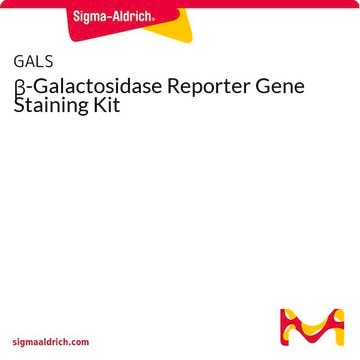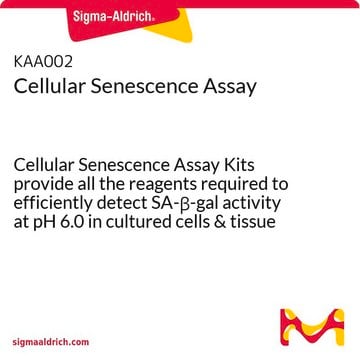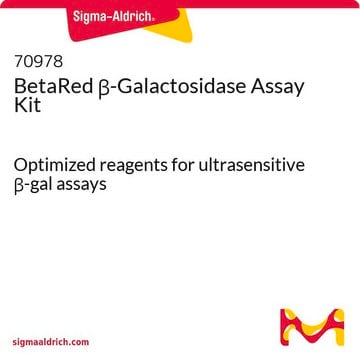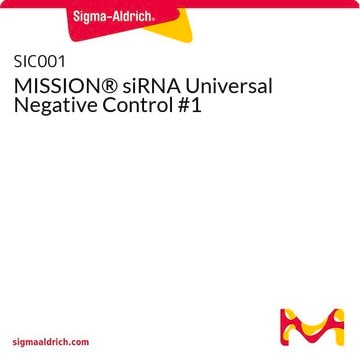This kit has not been tested for use with confocal or fluorescent microscopes. X-gal staining does not involve a specific wavelength and it would be up to the end user to determine suitability. Note below, in a previously submitted question, that this kit has not been tested for dual staining with fluorescent dyes.
CS0030
Senescence Cells Histochemical Staining Kit
sufficient for 100 tests
Synonyme(s) :
Senescent cells IHC kit, cellular β-galactosidase probe
Sélectionner une taille de conditionnement
559,00 $
Sélectionner une taille de conditionnement
About This Item
559,00 $
Produits recommandés
Utilisation
sufficient for 100 tests
Niveau de qualité
Conditionnement
pkg of 1 kit
Conditions de stockage
dry at room temperature
Méthode de détection
colorimetric
Conditions d'expédition
dry ice
Température de stockage
−20°C
Description générale
Application
- senescence-associated β-galactosidase assay
- to test for senescence in human pancreatic cancer cells
- adipose-derived stem cells (ADSCs)
- cord blood mesenchymal stromal/stem cells (CBMSC)
Actions biochimiques/physiologiques
Informations légales
Composants de kit seuls
- X-gal solution 4 mL
- Staining Solution, 10X 15 mL
- Fixation Buffer 10x 15 mL
- Reagent B 1.5 mL
- Reagent C 1.5 mL
- Dulbecco's Phosphate Buffered Saline (PBS) 10x 60 mL
Produit(s) apparenté(s)
Mention d'avertissement
Danger
Mentions de danger
Classification des risques
Acute Tox. 3 Inhalation - Acute Tox. 4 Dermal - Acute Tox. 4 Oral - Aquatic Chronic 3 - Carc. 1B - Eye Dam. 1 - Muta. 2 - Resp. Sens. 1 - Skin Corr. 1B - Skin Sens. 1 - STOT SE 3
Organes cibles
Respiratory system
Risques supp
Code de la classe de stockage
6.1C - Combustible acute toxic Cat.3 / toxic compounds or compounds which causing chronic effects
Faites votre choix parmi les versions les plus récentes :
Certificats d'analyse (COA)
Vous ne trouvez pas la bonne version ?
Si vous avez besoin d'une version particulière, vous pouvez rechercher un certificat spécifique par le numéro de lot.
Déjà en possession de ce produit ?
Retrouvez la documentation relative aux produits que vous avez récemment achetés dans la Bibliothèque de documents.
Les clients ont également consulté
Articles
Tests sur cellules pour l'étude de la prolifération (BrdU, MTT, WST1), de la viabilité et de la toxicité cellulaires pour la recherche sur le cancer, la recherche en neurosciences et la recherche sur cellules souches.
Cell based assays for cell proliferation (BrdU, MTT, WST1), cell viability and cytotoxicity experiments for applications in cancer, neuroscience and stem cell research.
-
Can we use confocal/basic fluorescent microscope for capturing the expression of Beta Galactosidase after using this staining kit?
1 answer-
Helpful?
-
-
Is there a method to extract the stain from cells when using the Senescence Cells Histochemical Staining Kit (Catalog Number CS0030) for cells in transwell inserts where cell counting is not feasible?
1 answer-
The CS0030 kit is intended for cell visualization using a microscope and does not include a specific procedure for dye extraction from cells.
Helpful?
-
-
Does kit CS0030 include a counterstain?
1 answer-
No, the CS0030 kit does not include a counterstain.
Helpful?
-
-
Is there a protocol for staining HCHO-fixed tissue culture cells, specifically for cells growing on coverslips or slides?
1 answer-
For staining purposes, there is no significant difference between staining wells attached to a culture plate or cells attached to a coverslip or glass slide. The primary difference lies in the amount of reagent required for the staining. It is advisable to ensure adequate coverage of the cells, and the insert contains a table that provides guidance on the amount of reagent required for staining.
Helpful?
-
-
I have been using it well for a long time. thank you I want to stain beta-gal staining and apoptosis-related IF together. Is there a recommended order or method?
1 answer-
The CS0030 kit has not been tested for use in dual staining, it would be up to the end user to determine suitability. There are several factors to consider with regard to attempting this modification.
1. The CS0030 includes a fixation step. Cells are not viable at the time of staining. Therefore any 'live cell' fluorescent stain would not be suitable following fixation.
2. There is an incubation period of 2 hours to overnight. This may deplete or cause certain fluorescent dyes to fade which would mean a 'one-time use' for visualizing the IF-stained cells.
3. The staining mechanism for CS0030 is pH dependent. This may not be suitable for some fluorescent dyes.
4. One possible robust fluorescent stain to consider would be DAPI, which could be applied following the b-gal staining. DAPI will stain fixed cells and can be preserved if stored in the dark.To discuss further, please navigate to the link https://www.sigmaaldrich.com/techservice, and click on "Product Technical Inquiries" under the Products Section with all the required information so that a member of the Technical Service team can reach out to assist further.
Helpful?
-
-
Can Product CS0030, Senescence Cells Histochemical Staining Kit be used with fixed cells/tissues?
1 answer-
Product CS0030, Senescence Cells Histochemical Staining Kit was designed for use with fresh (not-fixed) cells. The kit contains a fixation buffer to fix the cells. It is 10% formaldehyde, 1% glutaraldehyde in DPBS at 1X. The cells will be fixed prior to staining. The staining will show the beta-galactosidase activity that was present at the time of fixation.We tested the kit only on cells and we have no experience with tissue sections. The following papers use an assay for ßGAL on tissue sections which suggests that the kit will work with tissue sections.Castro P, et al., Interleukin-8 expression is increased in senescent prostatic epithelial cells and promotes the development of benign prostatic hyperplasia. Prostate, 60(2), 153-159 (2004).Chen, Z., et al., Crucial role of p53-dependent cellular senescence in suppression of Pten-deficient tumorigenesis. Nature, 436, 725-730 (2005).
Helpful?
-
-
What is the Department of Transportation shipping information for this product?
1 answer-
Transportation information can be found in Section 14 of the product's (M)SDS.To access the shipping information for this material, use the link on the product detail page for the product.
Helpful?
-
Active Filters
Notre équipe de scientifiques dispose d'une expérience dans tous les secteurs de la recherche, notamment en sciences de la vie, science des matériaux, synthèse chimique, chromatographie, analyse et dans de nombreux autres domaines..
Contacter notre Service technique












